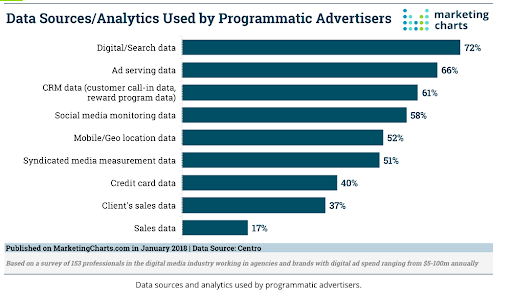The world of paid media is quickly evolving to keep up with all of the new media opportunities available to consumers – streaming services, new social media platforms, retargeting, geotargeting, voice search. Along with these new advertising mediums, there is also a new way to go about placing media – programmatic.
So what is programmatic advertising? Programmatic ad buying is the use of automation via software to buy digital advertising. Programmatic buying uses machines and algorithms to purchase display space rather than humans. According to an Adobe Think Tank, by 2022, 80% of advertising processes will be automated. I imagine that the word “programmatic” will drop off at some point and just become “advertising” since this is the way things are headed.
Programmatic allows for brands to make smarter, more targeted ad campaigns. The software uses collected data to decide which advertisements to use, and how much it costs. The goal for brands is to get their ad shown to the right person, at the right time, for the least cost. There is a ginormous number of ad networks and places that you can serve up your ad. Programmatic uses technology to make the best recommendation that will drive results.
So what are the data points used in programmatic buying?

Based on research conducted by Centro, the 3 most valuable data sources used are search, CRM, and ad serving data.
These data sources are then used with an algorithm to make a recommendation for ad placement, within milliseconds. The ads are bought and sold in a real-time marketplace. The best programmatic buys still have a human monitoring and bidding though, not just “setting it and forgetting it”.
What are examples of programmatic advertising?
You’ve probably heard of many of these, and may even be implementing them in your marketing. The key is connecting them all together, along with other key data points that will make your media buy as effective as possible. Some of the most popular types of programmatic include:
- Search/Pay-per-click
- Display
- Social
- Connected TV – This is any advertising placed on a TV connected to the internet
- Over-The-Top – This is the video content people stream from the internet instead of broadcast, cable, or satellite TV. This includes services like Netflix, Disney+, Hulu, etc.
- Audio – Spotify, Pandora
- Digital Billboards
Should I be using programmatic advertising for my organization?
Great question! Programmatic can be a great tool for organizations to reach targeted audiences with relevant content – a goal that any organization strives to achieve. But who is it right for? Here’s my thoughts on when you should consider programmatic.
- Do you have a dedicated media budget? If you don’t have a budget dedicated to media, programmatic is not the place to start. You do need a significant budget for a programmatic campaign to be optimized and really work.
- Do you have data that can be used to help make the ads more targeted? CRM data, member data, conversion data, purchased lists, etc.? Programmatic works best when you have data to utilize. If you’re just starting to gather your own first-party data, pursuing a different digital advertising direction may be a better place to start.
- Can you offer specific content or products to an individual based on their interests and behaviors? Programmatic is all about providing a specific message to users at the right time based on their audience behavior signals. Personalized messages are the name of the game. And if you don’t have the content or products to offer them, it won’t work.
- Have you done display advertising in the past? If you’ve worked with Google Display Network (GDN) in the past, programmatic is a great next step. If display is new to you, GDN is a great place to start and learn before you dive into the deep end.
- Are you able to track through to conversion? If you can’t monitor what your ad conversions are, programmatic won’t benefit you. Focus on getting your site able to track conversions, including view-through conversions.
Thinking that programmatic might be right for you and want to explore your options? Let’s talk.
